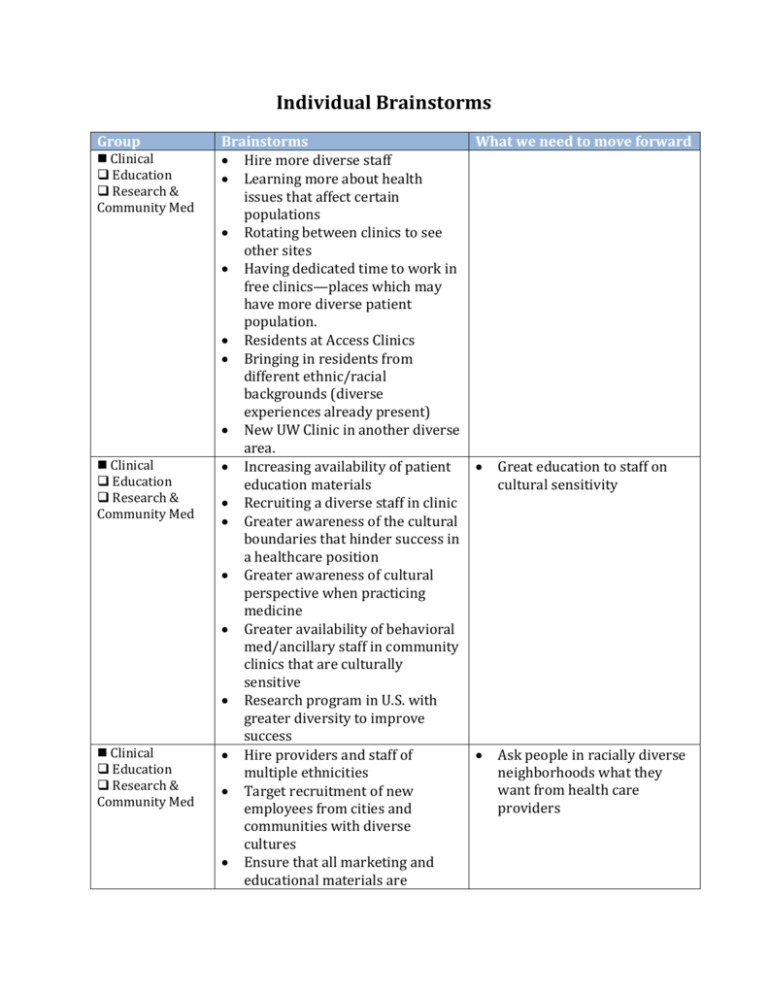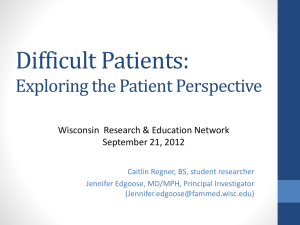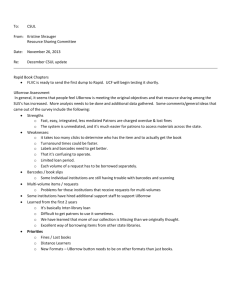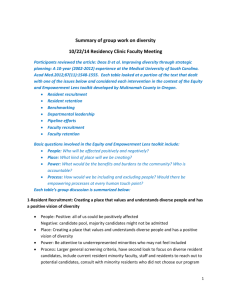Individual Brainstorm
advertisement

Individual Brainstorms Group Clinical Education Research & Community Med Clinical Education Research & Community Med Clinical Education Research & Community Med Brainstorms Hire more diverse staff Learning more about health issues that affect certain populations Rotating between clinics to see other sites Having dedicated time to work in free clinics—places which may have more diverse patient population. Residents at Access Clinics Bringing in residents from different ethnic/racial backgrounds (diverse experiences already present) New UW Clinic in another diverse area. Increasing availability of patient education materials Recruiting a diverse staff in clinic Greater awareness of the cultural boundaries that hinder success in a healthcare position Greater awareness of cultural perspective when practicing medicine Greater availability of behavioral med/ancillary staff in community clinics that are culturally sensitive Research program in U.S. with greater diversity to improve success Hire providers and staff of multiple ethnicities Target recruitment of new employees from cities and communities with diverse cultures Ensure that all marketing and educational materials are What we need to move forward Great education to staff on cultural sensitivity Ask people in racially diverse neighborhoods what they want from health care providers Clinical Education Research & Community Med Clinical Education Research & Community Med developed with diversity in mind Train employees to be welcoming of people of all ethnicities Invite patient of varying cultures and ethnicities to participate as patient advisors on committees or workgroups Identify neighborhood “champions” who can take health care initiatives back to their neighborhood Attempt to better locate future facilities in diverse neighborhoods (trend has been to do opposite) Work on getting full demographic (race ethnicity) information into EPIC Develop community panels (with diversity) for each clinic and make them functional Continue to recruit clinicians, faculty, PA’s and residents of diverse backgrounds Provide adequate compensated clinical time for appropriate cultural competency training Have community liaisons to bring people in—like health educators from the target populations. Market on the bus, if we don’t already Host community events at our clinics Be present in community spaces Clinical Education Research & Community Med Prioritize PCC/educational topics that use new EBM data for underrepresented groups Work in EPIC to highlight demographics Assure diverse patient panels in resident schedules Recruit MA’s, Lab Techs, LPN’s and RN’s with wider diversity Front desk (reception) needs to reflect communities served! Hire doctors and staff from underserved or underrepresented populations we want to attract Find out what target populations concerns about health and wellness are; market to those concerns Tell target populations we can about them, talk openly about health care disparities Work in EPIC to highlight demographics, social determinants and or hardships—make part of the problem list so can be tackled Clinical Education Research & Community Med Clinical Education Research & Community Med Clinical Education Research & Community Med Remove barriers for getting access to in IM, specialty, ICare(?) for patients in disadvantaged/underrepresente d groups Make intentional community relationships with YWCA, the Urban League, NPC, etc. Make relationships and perform community needs assessments, then use (reallocate) DFM funds to meet Use resident community health projects as assistance in this effort and better comp;ensate them for that time (i.e., allow for “Community Health Week, not just ½ day here and there) Identify minority faculty residents and staff publicly/within the department if they give permission Offer to assign patients of that minority to same minority providers and staff Co-location of health benefits counselors at resident/community clinics Training/support/utilization of community health educators Spanish language training for residents to provide crosscultural care Greater EPIC tools in Spanish (letters, AVS, etc.) Change UW HR policies to allow positions (faculty) to be held for specific recruitments (gender, race, etc) to better meet the needs of the patients (sensitive data). Advertise in appropriate venues. Develop mentoring opportunities or internships Rejoice when we have successes as such Promote increased diversity in clinical care staff from the front desk to PCP via intentional hiring practices— consider local neighborhood advertising for open positions Recruit more at risk minority residents, faculty and staff to the department Continue to make local and national health disparity issues highly visible within the department and UW Early resident didactics on health disparities, cross cultural care Active recruitment of diverse faculty/residents Great links to undergrad and medical school groups of students of color Look for leadership/ administration opportunities which increase visibility Clinical Education Research & Community Med Clinical Education Research & Community Med Clinical Education Research & Community Med in this area Clearly define diversity for use in this exercise. Is it ethnicity, socio-economic, LGBTQ? Ensure that methods of staff recruitment are open to diverse candidates Align clinical staff to patient mix; i.e. need for other than Englishspeaking staff to better meet the needs of non-English speaking populations Reimbursement or pull-back on clinical schedule to promote teaching and mentoring of minority students Identify and train succession plans and recruitment of current minority leaders to build minority leadership within the department Use current staff to help with recruitment of minority hires Provide “community” within the department with meetings and support Feedback from current staff to improve Seek to build clinic staff diversity to mirror the community served by the clinic Monitor clinical outcomes data by race/ethnicity to identify inequities in clinics Monitor and discuss this data, seek to understand underlying issues and distribute widely and frequently Engage with individual patients and communities to see solutions Train staff to use diversity friendly and respectful language with all patients (e.g., around gender identity) Involve a diverse group of Regular training of staff in topics to address cultural sensitivity; not once in a while but a process of continuous improvement Training for management supervisory staff in how to effectively lead a diverse team to meet needs of patients Department financial support outside of CME to support conference attendance for diversity health equity training Additional time off for CME or special time off for diversity conferences Allow time for staff/faculty for community engagement with minority communities Clinical Education Research & Community Med Clinical Education Research & Community Med Clinical Education Research & Community Med patients in clinic initiatives Survey persons of diverse background—must be anonymous Find a way for use (circle graphs) to easily see diversity in our department in past five years (diversity in clinic staff) Find out if we’ve ever had reports of racial bias in HR (“are we not including everyone?”) Look at our advertisements, our TV spots, our AV/TV equipment content in clinics—how diverse is it? How well do we handle patients who can’t speak English (pharmacy)? How well do we handle transgender patients (so we know when to change the gender on charts for example)? How well does staff and administration in clinics understand needs of LGBT population? Employ a full-time position for equity issues and promotion in the department Allow protected faculty time to work on initiatives Have residents complete community project during their residency specifically aimed at underrepresented communities Decentralize care and care not inclusive if only happens in clinic Hire support staff from different backgrounds Signage in clinic in several languages Ask patients what works for them Increase minority faculty, resident and staff recruitment and retention Actively reach out to area minority community organizations to work together to achieve goals Workshops to examine our own biases with patients Allow visits that are not charged—currently only seeing patients who can afford care Too much focus in clinic on “best care” for those with insurance, not improving care for those without Clinical Education Research & Community Med Clinical Education Research & Community Med Clinical Education Research & Community Med Clinical Education Research & Community Med Specific education: topics, waiting room promoting needs Training clinic groups, activities to promote awareness of racial disparity Patient advisor groups Creat neighborhood connections, adopt a school, etc Awareness of racial disparity in teaching communication Expand how we look for applicants, seek out people Talk with staff about diversity to get it on everyone’s radar Identify other departments that are doing this well and learn from them Adapt recruitment process to make it more appealing to wider range of applicants Asking current patients from diverse communities what works, doesn’t work, and could work better in our care system Concerted effort to build a language component system (phone, reception, nurse, lab, provider) for specific languages (Spanish, Hmong, Deaf) More convenient hours and locations for working poor More upfront assistance for uninsured (and underrepresented) patients, beyond “Community UWMF Care” Diverse art on walls in clinics World music in background Patient family advisory group recruitment of diverse members Have patient education material that highlights diverse populations Start a health equity journal club—reviewing major issues in health equity Hire more staff of color, offer educational advancement, more reimbursement? Offer transportation for low income patients Build diversity into formula for hires Have regular seminars about diversity/equality, build into clinic education days for residents Survey staff anonymously about what we are and are not doing well here Hire (and retain) more diverse clinic staff at all levels; robust staff development; especially more diverse patient contact staff Periodically review the clinical warehouse data re: health equity issues—i.e., HTN, DM management in different populations Provide staff and managers Clinical Education Research & Community Med Clinical Education Research & Community Med Clinical Education Research & Community Med Clinical Education Research & Community Med More minority clinicians across the board, MA’s, RN’s, medical providers, etc. Patient and advisory panels representing the diversity of the various clinics More minority faculty A clinical equity and diversity award given annually to a faculty, resident to clinical staff member for contributions (e.g. clinical program innovation) relevant to equity and diversity More QI in clinic relevant to equity and diversity Dedicated time to “know your community”—residents in Milwaukee have one month community medicine rotation Community health workers (ten people who are leaders in community to be spokesperson/advocate) Empower community resource reps (health education/SW) to address patient needs Having an open heart Patient centeredness Appropriate poster/signage Culturally and language concordant(?) staff and providers Community Advisory Board Education topics that involve diversity issues Community health education Reaching out to doctors in different areas to provide rotations in different diverse areas Reaching out to doctors to provide seminars on diverse topics education in health equity and diversity issues More education for resident, faculty and staff on the social determinants of health care Identify other people to bring to the table (physician/caregiver leaders with diverse backgrounds) Review “cultural diversity in the workplace” materials/research/projects Cultivate young leaders to “start the conversation” Time to set goals: reassess progress; and set more goals Clinical Education Research & Community Med Clinical Education Research & Community Med Having residents provide education around the city and in different diverse areas Residents into schools talking to students about being a doctor— go to diverse areas, different cities Need to have our program and administrative offices in a physically accessible space (Alumni Hall is not!) Incorporate disparities data in educational presentations about clinical conditions Improve outreach to medical school minority student associations “Frist Look” in residency recruitment rather than second look Patient panels to address our patients of various backgrounds, how to deal with handling their backgrounds Teaching our learners how to handle their needs Better support/mentorship for minority student and residents Creating more open environment for addressing questions/dialogues about issues pertaining to race and disparities More home visits More involved with schools— middle students and high schools More formal relationships with community organizations as a department Food! (___ expose to other cultural experiences) Action outreach to students and preceptors Include patients, their family members, other community members as advisors and copresenters in educational endeavors within DFM Provide culturally, ethnically, racially specific resource information for residency applicants if they are interested in it Clinical Education Research & Community Med Clinical Education Research & Community Med Clinical Education Research & Community Med Diversity Grand Rounds—talks from URM patients to residents and faculty Field trips to community cultural centers, etc. Bulletin boards and email education Support for national conferences and cultural fellowships for CME Diversity book club Annual diversity education symposium in department For residency recruitment could we start a partnership with a medical school for example in Ethiopia so we could train their residents and then they could be ready to be faculty at the residency program there. Addresses our commitment in global health and diversity Somehow we need to make our residency program more attractive to a broader group of people—focus on hiring more diverse faculty, continue to build community partnerships that foster building diversity and inclusion Devise more set criteria that is for applicants screening that values differences—applicant screening and involve more people in recruitment committee Have more targeted lectures about institutionalized racism beyond what is traditionally taught (i.e. Tuskegee) I would be interested to have conversations, for example, about how physicians treat the pain of African American patients vs. white patients Recruit and hire faculty who have an interest in this area Members of faculty, residency, and clinic staff promote diversity and teach each other Forum, series, and symposium Integrate issues of diversity into more lecture that we give on “basic science” topics (i.e., how does race/racism/cultural determinants of health impact HTN) Build coalitions with other departments at the UW (History of Medicine, Women’s Studies, African- Clinical Education Research & Community Med Clinical Education Research & Community Med Clinical Education Research & Community Med Recruit more diverse residents and again have key members in recruiting pursue diversity training Benchmark # of lectures that attend to issues of health equity and diversity Mark diversity and health equity a visible presence in our webpage (on the front) to attract applicants—also in recruiting materials and presentations Recruit more broad—consider FMG (e.g. from Cuba) Develop strong ties with the community in residency curriculum All above also can substitute medical student with resident Track number of applicants in underrepresented minorities who ge interviews Make more intentional connection with applicants and faculty of similar backgrounds Include racial disparities into training as a larger part of the community health rotation in R1 year Integrate information about health equity into all clinic-based educational afternoons or clinic discussions about any care initiatives Health policy Embed LOCUS of medical student education within underserved neighborhood Establish baseline of URM among residency applicant pool Collaborate with community American Studies, Sociology, History, etc) and have guest lectures come in to discuss hx of racism in healthcare Need more diverse faculty— create a diversity committee that is specifically trained and have one member that sits on all hires of faculty Evaluate lectures for whether they address health disparities Develop residency curriculum on racial disparities and around issues of implicit bias, microaggression, white privilege, race equity toolkit Embed LOCUS of residency education within underserved neighborhood Specifically design residency recruitment outreach for specific URM groups/schools Clinical Education Research & Community Med Clinical Education Research & Community Med Clinical Education partners to provide longitudinal career mentoring for youth (pipeline process) Expand diversity and inclusion to intentionally include rural Recruitment of underrepresented minorities—residents, staff, faculty Make political engagement, advocacy around this topic as part of the curriculum Create sustainable community medicine projects that can be passed between residents that address these topics (i.e. patient family advisory council, something similar to the Ladder program—mentoring youth with an interest in health careers) Invite the marginalized to meet with us regularly Give feedback to the community regularly Have a physical presence in the communities in need: open clinics/offices in neighborhoods where needed Focus research efforts on local community-based participatory research HIRE community members from these communities to staff clinics TRAIN community members to engage with our department Explore new models of care (e.g. group visits at churches, community centers, social centers) Promote health norms using people of wisdom (elders) Establish community relationships (Moorehouse, Howard University) Intentional advocacy as part of curriculum (recruit URM), clinic staff Community medicine projects—CABS: longitudinal/sustainable Research & Community Med Clinical Education Research & Community Med Clinical Education Research & Community Med Recruit more residents, faculty and staff with experience and interest working in communities Value and support activities in communities Develop curriculum towards educating residents, medical students, faculty, etc about working with communities Involve communities in curriculum planning Establish communities advisory boards Sponsoring community events Working on participatory research Making sure our department faculty, staff and learners reflect the communities we work in Understanding the needs in our communities Formal mentorship—avenue for exposure to medicine “Gentleman and a scholar” program—partnering with the Urban League, Nehemiah Project and offer DFM faculty and residents as mentors for African American youth aspiring to be physicians MEDiC campaign to raise awareness at either the disparities or the programs/efforts to decrease disparities Bring minority community member together to discuss these issues and participate in the solutions Gather leaders at community groups and programs already focused on these issues and ask them how we can partner with them or pick their brains School partnerships for “ask a Being more present at community events Partnering with groups in the community—having a consistent presence in community programs Clinical Education Research & Community Med Clinical Education Research & Community Med Clinical Education Research & Community Med doc” sessions Recruit research faculty who are engaged in equity or community health research Create/develop robust mentorship program for researchers in the field Continue to develop community health residency rotation to make this a core component of the resident experience Create space in residency, fellowship, and promotion track for all participants to engage in community activities Make promotion criteria more flexible to allow for important community-level work Create a mentorship program for youth from diverse backgrounds interested in careers in health or public health Create a community advisory board for DFM charged with promoting health equity, diversity, inclusion Provide greater support for community engaged research partnering with communities of color—funding, grant writing support, staff support Creat job pipeline/training program/ paid internships for youth of color in UW Health in all different areas of organization Create CHW program directed/owned by communities service Develop a research fund in DFM small grants for disparities research at the clinic level Use PCORI guidelines (good but not sufficient) to “Score” DFM grants with priority points for grants that include significant Clinical Education Research & Community Med contributions from patients or community members or groups Have faculty development program that feature CBPR as an approach to community research Have grant rounds quarterly featuring examples of community-based research from UW Madison Have one way of faculty getting citizenship points is to engage in citizenship—join community boards, neighborhood organizations, volunteer, and non-profits Have faculty invite residents to be volunteer members of citizenship activities with community groups Have each clinic—not just teaching clinics but all DFM clinics—have formal patient advisory committees where faculty and senior residents are encouraged to attend and help form the agenda Feature alumni in the alumni newsletter who are particularly engaged with communities as part of their community service Conduct research about health disparities in our own practices Conduct training for existing faculty on community based participatory research techniques Hire faculty who are interested in community-based participatory research; have longitudinal relationships with community organizations Whenever patient data and quality are reported, include breakdown by race, age, gender Develop pipeline programs— research projects starting even Develop longitudinal relationships between faculty, residents, and staff with community organizations that support issues of diversity and health equity Clinical Education Research & Community Med Clinical Education Research & Community Med with high school and undergraduate students Partner with other departments in the University and others For resident community health projects, connect them with community organization and develop project based on community need rather than resident interest alone Hire faculty and staff from underrepresented minority communities Departmental grants to support research in underrepresented minority communities Seek funding for research projects aimed at inequity and diversity Engage with community members from all walks of life Seek collaborations with other entities doing diversity research Promote discussion of issues relating to inequity and marginalization Amplify voices of those not usually heard Engage with policy-makers working on diversity and inclusion issues Place diversity issues on agendas for meeting Establish diversity forum and provide resources and support Differences in fall prevention screening between AfricanAmerican, Caucasians, Hispanic and Hmong patients Differences in inappropriate medication prescribing in older adults of various ethnicities Focus group questions to communities of color on how to increase health careers in Prioritize diverse people and viewpoints when hiring Clinical Education Research & Community Med Clinical Education Research & Community Med Clinical Education Research & Community Med minority students Develop a disparities track that recruits fellows and faculty to perform research, CBPR Researchers and community engaged faculty talk to minority interest groups about our work Target SSRCA positions to community engagement/disparities research HR trains faculty who build research teams on best practices around diversity Communication on research and community engagement talks about our efforts Data kept on our hires, fellows, faculty Survey of faculty and staff, etc, in research Community stakeholder activities and meeting around issues of clinic function and structure Outreach to community groups of diverse background, AfricanAmerican, Hmong, Latino/a, etc. Broaden the notion of community stakeholder on a clinic basis Partner with communities and community organizations Designate specific funds for diversity and equity related research Seek out and learn from others successfully engaged in this type of work Actively recruit minority faculty in Centennial Scholars Program Create a community advisory board in partnership with lead minority agencies that can inform about DFM research at community engagements EHR QI projects devoted to assessment of basic health measures with a population focus EHR assessment of preventive services per identified group Affirmative action hiring practices Develop an advisory committee composed of community members Develop research and community engagement projects and programs that involve diverse medical students, undergrads, HS or middle school students





